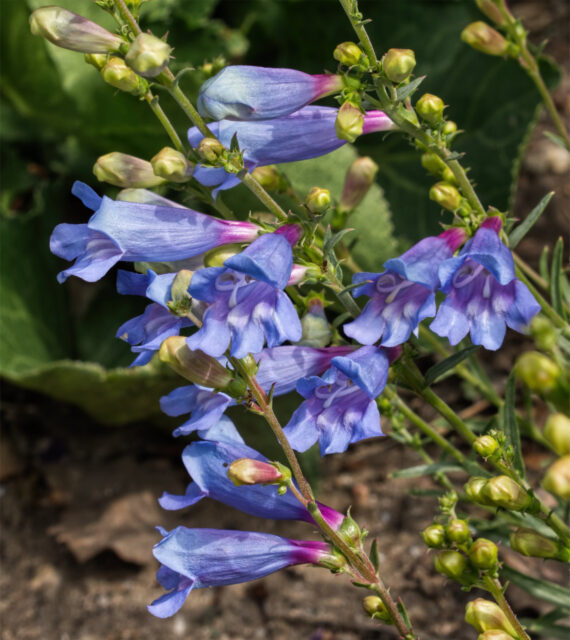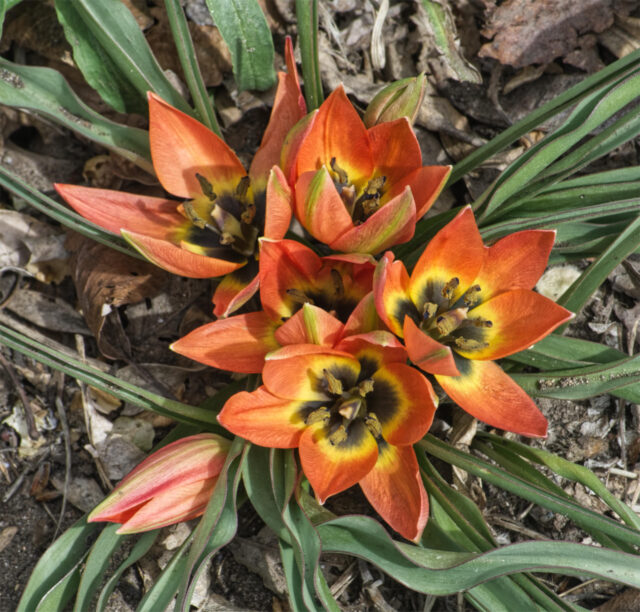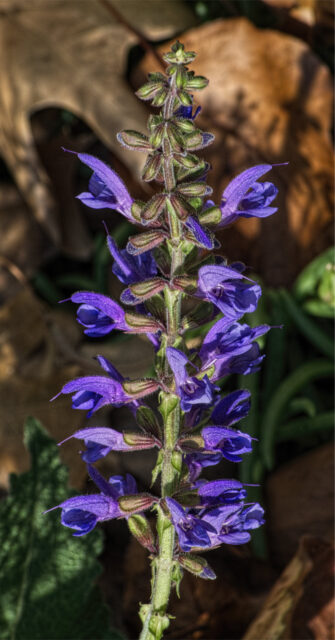Category: Botany
What month is it?
While most of the yard is dormant, one of the daffodils got the dates mixed up and is blooming now. Unless the temperature gets extremely cold soon, I should have flowers in the garden for Christmas.
Update, January 1, 2025: still blooming, but not for much longer. Snow and single-digit temperatures arrive Sunday, according to the weatherman.
Botanical links
Most horticultural writers live in places where the climate is temperate and gardening is easy. This is understandable; if you are obsessive about plants, you would probably choose to live in a place where many plants grow well. The books they write are for readers in similar areas, where the same plants flourish. Such books are of little use to gardeners in Kansas, where it is either too hot or too cold, usually too dry and always too windy. I have yet to find one I can recommend. However, I discovered a downloadable pamphlet that actually is of use to people in Flatland: Garden Design with Native Prairie Plants.
*****
Nero Wolfe, the great and large detective, grew orchids. Here’s a list of the genera mentioned in the books, and Archie Goodwin’s account of Wolfe’s activities as an orchid grower.
Incidentally, if you are as much a fan of the FBI as I am, you might enjoy the Wolfe mystery The Doorbell Rang.
*****
Talon Buchholz, who for many years ran a nursery in Oregon, maintained the Flora Wonder Blog. In it he discussed various horticultural matters such as evergreens, nomenclature, plant explorers, gardens elsewhere, propagation, and much more, all with lots of pictures. And maples, a particular interest of Buchholz. If you want to see the variety within the genus Acer, browse through Flora Wonder. Buchholz recently retired from blogging, but the blog remains and is worth perusing.
*****
Out-of-seasonal note: Walmart has already replaced gardening supplies with Santa crap. This is unfair.
Additional garden notes
Grasshoppers have been a plague, as usual. The only control I have found that works at all is the orb weaver spider. I observed one in my garden wrap up two grasshoppers almost as large as itself in five minutes.
Roundup is no longer Roundup. It used to contain glyphosate, and it was the best chemical solution for most weeds, particularly invasive, difficult-to-dig-out grasses like bermuda.1 However, it’s been reformulated without glyphosate, and it no longer reliably kills weeds. I sprayed the above plant above three weeks before I took the picture. With the old Roundup it would have been completely dead and ready to scrape off the pavement. With the new, disimproved formula, it looks uglier than it did before but is still vigorously growing. I checked every herbicide at Home Despot; not one of them contains glyphosate any more.
Sleep, creep, leap: the conventional wisdom is that growing perennials from seed to bloom takes three years. The first year they produce just a few leaves and concentrate on developing their roots; the second year there is more top growth but most of the action still takes place underground; the third year they’re ready to put on a show. I find that this may be true of some, but most are quicker. I’m still waiting for the Baptisias, Asclepias and the rest of the Silphiums that I started last year, but all the Penstemons bloomed this year. Quite a few bloomed well their first year, e.g. Helianthus, Aster Symphyotrichum, Dianthus, Rudbeckia, Echinacea.
I spotted the above while reviewing Monty Python recently. The yellow flowers look like Mentzelia, possibly M. lindleyi — a plant of the American west, and not something I would have expected from a bunch of silly Brits (and an expatriate American).
Gardening year in review
The enormous clump of Helianthus maximiliani, seven feet tall, has just started blooming, and the much smaller Tricyrtis will follow in a few days. Otherwise, the garden is pretty much done for the year. This is as good a time as any to look back and see what did well and what didn’t, and what did too well.
What color?
Horticulturalists see colors differently than most people. I’ve mentioned before that “coerulea” forms of orchids look lavender to me, not blue. Something similar happens with daylilies. This is “Hall’s Pink.”
Does that look pink to you? Parts of it may look a bit pinkish, but overall I’d call it orange.
“Artist Etching” is generally described as “pink.” Judge for yourself.
Meanwhile, “Snowy Apparition” is called “near white.”
Not very “near” to my eyes. I’ve seen pictures online in which it does look very pale, but the plant in my garden is definitely yellow.
It’s possible that in a different garden with different conditions, or photographed at different times of the day under different lighting, the colors may be truer to their descriptions, but calling these “pink” and “white” is wishful thinking. Still, even though the colors are not as advertised, they’re reliable plants that bloom well.
White enough to cross your eyes
A new orchid opened this week. It’s a Cattleya hybrid from Sunset Valley Orchids, “Lc. Arctic Moon ‘Rochelle’ x C. Ruth Gee ‘Diamond Jubilee’.” The picture is a cross-view stereo pair; to see the orchid in three dimensions, cross your eyes so that you right eye focuses on the left image, and vice versa. It’s easier to do than to explain how.
Another Catt hybrid, “C. mossiae f. coerulea ‘Blue Moon’ x L. sincorana f. coerulea ‘Dark Blue’,” is also in bloom. Fred Clarke listed this as a “blue” Cattleya, but it looks lavender to me.
If you’d like more practice crossing your eyes, here’s an Achillea:
More snapshots

Eventually I’ll get back to books, music, animation and the collapse of civilization, but for the moment my focus is on my garden. Here are some recent pictures. There are more at my Flickr page.
So …
… will it rain? While much of the prairie has been getting an overabundance of weather, out here in the middle of nowhere there has been virtually nothing. April showers this year amounted to .16 of an inch. It’s dry, and we need some real rain, not just a bit of drizzle. Yesterday the weatherman predicted a 100% chance of rain tonight, and I thought, yeah, right. He’s predicted heavy rain many times this year, but as the moment approaches the probability diminishes, the “thunderstorms possible after” time gets later and later, and ultimately that inch of rain becomes just a trace, or nothing.
Tonight, however, it looks like rain might actually fall. The chance of rain is at 90%, not the 60% or 40% that it would typically have been reduced to by this time. The arrival time has been postponed to after 3 a.m. and the amount expected is down to a quarter inch, which are not good signs, but nevertheless it looks like we might get enough moisture to make a difference.
Update, the morning after: We got about an inch of rain, starting shortly after midnight.
Despite the dryness the garden is doing well. Snapshots are below the fold.
New blue

The first of the penstemons opened this week. The others I planted last year are heavily budded and should put on a good show over the next couple of months. This year I put in a bunch more, focusing on blues and reds, to see which species will survive in Kansas.
More snapshots from the garden under the fold.
A bit of color

Spring is definitely here, about three weeks early. The 16℉ late in March did surprisingly little damage, and most things are rapidly growing. Here are a few of the current highlights.


***
Grr. WordPress logged me out while I was assembling this post. Even though the “Howdy” message remained at the upper right, I couldn’t see the page preview. I had to relog using the login under the “Meta” heading on the weblog page to finish this post.
Historical-botanical footnote
Joseph Moore’s most recent post mentions the Iron Chancellor. That reminded me of a bit of horticultural history.
One rose I grew many years ago was a fine white hybrid perpetual called “Frau Karl Druschki.” That’s a bad enough name, but it could have been much worse. From an online discussion:
According to a reference, for some years from 1900 there was an annual competition for the best new seedling of German origin, to be named ‘Otto von Bismarck’. The rose described here is pink, from 1908. However there is an illustration dated 1900. Was that a different rose? (Or as a passing thought, a typo?)
1900 was the year that the rose eventually named ‘Frau Karl Druschki’ was entered in the competition….… ‘Frau Karl Druschki’, at the time still unnamed, had participated in the original competition in 1900, but the judges found no rose to be good enough to be called ‘Otto von Bismarck’. So, Lambert named his rose FKD and commercialzed it and was out of the game. The original prize money of 1000 Marks was increased first to 2000, then to 3000, to no vail – nothing was good enough! Finally in 1906 Kiese’s rose made it. The irony is that FKD went on to become one of the hottest introductions of the early 20th century, while Kiese’s ‘Otto von Bismarck’ almost disappeared.
You can call the rose “Snow Queen” or “Schneekönigin” if you find “Frau Karl Druschki” too clunky.
*****
Bonus foolishness: A note from the Modern Language Association’s annual meeting:
But amid the usual carnival of perversity there was one bijou we thought might interest our readers. No, it has nothing to do with, you know, literature. The denizens of the mla and indeed of the humanities departments of most of our universities wouldn’t countenance anything so retrograde. But how’s this, a session on “Vegetal Afterlives”?
“Advancing recent work in critical plant studies”—“critical plant studies”? alas, yes—“asking how plants offer vibrant models of resistance to environmental destruction through their persistent attempts to create a Plantocene, . . . panelists focus on the theme of vegetal resistance, considering how plants can offer models of resistance for human crises like systemic racism, unnatural disasters, and climate change.”
First
After a brutal January, it looks like we’re heading for an early spring. The daffodil above opened yesterday, unscathed by the 13℉ freeze Saturday morning. This is the second-earliest daffodil I’ve seen in Kansas. (The earliest bloomed February 17 fifteen years ago.) The forecast for the rest of the month looks like late March or early April. The weather may well double-cross me in March (it occasionally happens that the heaviest snow of a winter falls on March 20), but it’s probably time to clean up the garden and get it ready for this year’s experiments.
Update: The first Iris.
Old red
Last year’s very red cattleya is blooming again. Unlike this year’s, the older plant’s flowers are unequivocally red in every light.
Red, again
The first of this year’s new orchids bloomed this week. It’s another red one; nice, but not what I was expecting. The dealer’s notes2 indicated that it would likely have flowers in the magenta-purple range, but while it does have a bluish cast in some light (but not in sunlight or with the on-camera flash), it looks red to me. The other new ones probably won’t bloom for a year or two. When they finally do, one should be white and the other spotted.
(As usual, when WordPress resizes pictures to fit the column width, it also makes the colors duller. Click on the picture to see it larger and with more accurate color.)
Update: as the flower ages, it becomes bluer. It now is on the border between magenta and purple, even in sunlight.
Just before the end
It’s snowing steadily now, and we may get six inches today if the weatherman can be trusted. During the next few nights temperatures are likely to descend into the teens. Fall is over (though, because this is Kansas, December may well be warm and dry). Despite the hard freezes earlier, a few plants were still blooming yesterday, including this salvia. At this time tomorrow, everything will be solid white.


















